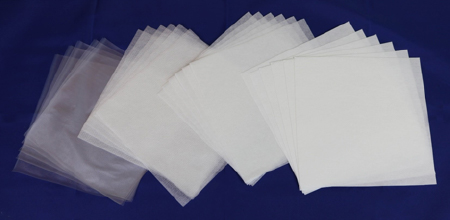Embroidery backing is important for a strong foundation when embroidering on different materials and styles. Backing is a sheet of material that is hooped and embroidered along with the fabric you are embroidering. The material acts as a stabilizer, supporting the fabric and stitches while you embroider.
I have worked on many decoration cases in which the choice of backing is why there was embroidery issues. One example is a lightweight beanie — they used a tear-away backing when a cut-away backing was needed due to the weight of the beanie.
Here’s a good rule to follow when trying to choose which backing to use. The heavier or thicker the fabric you are embroidering, the lighter the backing should be. The opposite applies as well — the lighter or thinner the fabric, the heavier the backing should be.
Please keep in mind the following factors when choosing backing:
- Stability of Fabric: Stretchy or loose fabrics, such as knit, require heavier backing while stable and tightly-woven fabrics need a light or medium backing.
- Stitch Density: The higher the stitch density, the more support the fabric needs to stay put, so heavier backing is needed for high stitch densities.
- Washability: If the fabric will be washed frequently, use a heavier backing. The backing will become softer after many washes.
Backing is available in three different weights for fabrics:
- Lightweight: 1 to 1.5 ounce fabric
- Medium Weight: 2 to 2.75 ounce fabric
- Heavyweight: 3 to 3.5 ounce fabric

Backing materials can also be a factor. The four main types of backing and what they’re used on are:
- Cut-Away Backing: This is used for permanent support, as it provides the most stability. Cut-away offers the sharpest embroidery on highly detailed designs, including small lettering. It remains permanently with the fabric and then you cut away the excess material.
- Tear-Away Backing: This backing is less stable than cut-away backing. Tear-away is used for light support and as it names says, it is removed by tearing it off from the garment. Tear-away backing is used on firmly woven fabrics that do not stretch, such as terry cloth, robes, blankets, leather, and caps. One big reason for tear-away backing is when you do not want the backing showing on back of towels, caps, and bags. There will be times the fabric needs strong support; you can use several layers of the tear-away backing for these fabrics.
- Poly Mesh/No-Show Backing: Poly mesh or no-show backing is a lightweight cut-away that is soft, thin, and strong. It is designed to provide additional stability to knit shirts. This backing does not show through light-colored garments, and is mostly used on polos and t-shirts.
- Aqua-Top Topping: This backing is a water-soluble plastic film used on the top of the embroidery design to prevent stitches from sinking into textured fabrics. Aqua-top is used to support delicate, mesh-like, and difficult fabrics like piques, fleece, terry, and corduroy. Topping is recommended when embroidering towels, as it will help the stitches stand out and not sink into the fabric. You will still need to use a stabilizer on the back of the fabric to stabilize the garment.
Picking the correct backing when embroidering on a specific fabric is a big step toward making sure you are producing the most vibrant, detailed, and exciting embroidery on the fabric.
